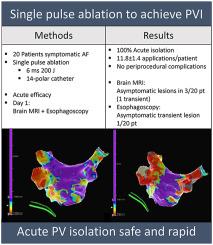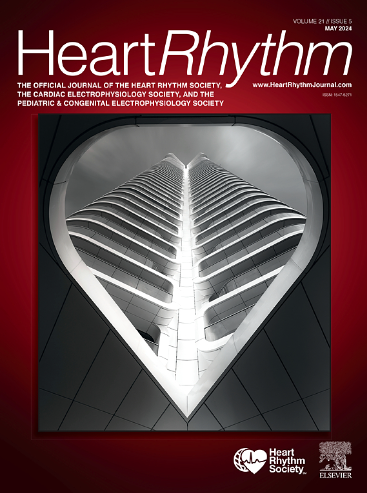Feasibility and safety of single-pulse ablation in 20 patients with atrial fibrillation
IF 5.7
2区 医学
Q1 CARDIAC & CARDIOVASCULAR SYSTEMS
引用次数: 0
Abstract
Background
Single-pulse ablation leads to irreversible electroporation (IRE) and has been introduced as a nonthermal ablation technology for pulmonary vein isolation (PVI). First-in-human studies demonstrated the acute feasibility and safety of IRE PVI.
Objective
This study aimed to further investigate the safety of single-pulse ablation for PVI.
Methods
Twenty patients with symptomatic atrial fibrillation underwent single-pulse PVI under conscious sedation. Nonarcing, nonbarotraumatic, 6 ms, 200 J IRE applications were delivered via a custom 14-polar circular IRE ablation catheter with a variable hoop diameter (16–27 mm). Adenosine testing was performed after a 30-minute waiting period. On day 1 after ablation, patients underwent esophagoscopy and brain magnetic resonance imaging (MRI) (diffusion-weighted imaging/fluid-attenuated inversion recovery).
Results
In 20 patients, all pulmonary veins could be successfully isolated with a mean of 11.8 ± 1.4 IRE applications per patient. One pulmonary vein reconnection occurred during adenosine testing; reisolation was achieved with 2 additional IRE pulses. No periprocedural complications were observed. Brain MRI on day 1 after ablation showed punctate asymptomatic lesions in 3 of 20 patients (15%). At follow-up MRI, the lesion disappeared in 1 patient whereas 1 lesion persisted in the other 2 patients. Esophagoscopy on day 1 showed an asymptomatic esophageal lesion in 1 of 20 patients (5%); at repeat esophagoscopy on day 22, the lesion had resolved completely.
Conclusion
Acute electrical PVI could be achieved safely and rapidly. Acute silent cerebral lesions were detected in 3 of 20 patients (15%) and may be caused by ablation or changes of therapeutic and diagnostic catheters over a single transseptal access.

单脉冲消融治疗20例心房颤动的可行性及安全性。
背景:单脉冲消融导致不可逆电穿孔(IRE),并已被引入作为肺静脉隔离(PVI)的非热消融技术。首次人体研究证明了IRE PVI的急性可行性和安全性。目的:进一步探讨单脉冲消融治疗PVI的安全性。方法:20例有症状的房颤患者在清醒镇静下进行单脉冲PVI治疗。非电弧、非气压创伤、6毫秒、200焦耳的IRE应用通过定制的14极圆形IRE消融导管进行,其环径可变(16- 27mm)。等待30分钟后进行腺苷检测。消融后第1天,患者行食管镜检查和脑MRI (DWI/FLAIR)检查。结果:在20例患者中,所有pv均能成功分离,平均每例患者11.8±1.4次IRE应用。在腺苷测试期间发生了一次PV重新连接,通过另外2次IRE脉冲实现了重新隔离。无围手术期并发症。消融后第1天的脑MRI显示3/20(15%)患者出现点状无症状病变。在后续MRI检查中,1例病变消失,2例病变持续。第1天食道镜检查显示1/20(5%)患者无症状食管病变,第22天再次食道镜检查病变完全消失。结论:急性电PV隔离可以安全、快速地实现。在3/20(15%)的患者中检测到急性无症状脑病变,可能是由于消融或在单次经间隔通路上更换治疗和诊断导管所致。临床试验注册:NL69129.041.19。
本文章由计算机程序翻译,如有差异,请以英文原文为准。
求助全文
约1分钟内获得全文
求助全文
来源期刊

Heart rhythm
医学-心血管系统
CiteScore
10.50
自引率
5.50%
发文量
1465
审稿时长
24 days
期刊介绍:
HeartRhythm, the official Journal of the Heart Rhythm Society and the Cardiac Electrophysiology Society, is a unique journal for fundamental discovery and clinical applicability.
HeartRhythm integrates the entire cardiac electrophysiology (EP) community from basic and clinical academic researchers, private practitioners, engineers, allied professionals, industry, and trainees, all of whom are vital and interdependent members of our EP community.
The Heart Rhythm Society is the international leader in science, education, and advocacy for cardiac arrhythmia professionals and patients, and the primary information resource on heart rhythm disorders. Its mission is to improve the care of patients by promoting research, education, and optimal health care policies and standards.
 求助内容:
求助内容: 应助结果提醒方式:
应助结果提醒方式:


